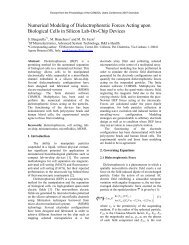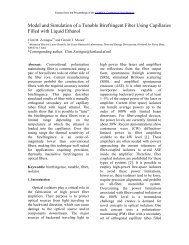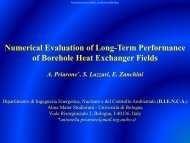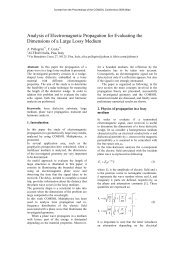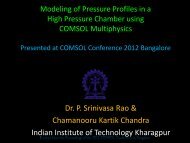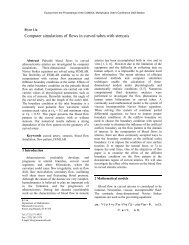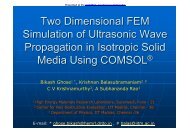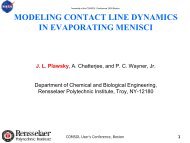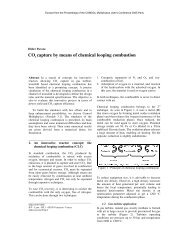The Use of CFD Simulations in Learning Fluid ... - COMSOL.com
The Use of CFD Simulations in Learning Fluid ... - COMSOL.com
The Use of CFD Simulations in Learning Fluid ... - COMSOL.com
Create successful ePaper yourself
Turn your PDF publications into a flip-book with our unique Google optimized e-Paper software.
Presented at the <strong>COMSOL</strong> Conference 2009 Boston<br />
<strong>The</strong> <strong>Use</strong> <strong>of</strong> <strong>CFD</strong> <strong>Simulations</strong> <strong>in</strong><br />
Learn<strong>in</strong>g <strong>Fluid</strong> Mechanics at<br />
the Undergraduate Level<br />
Marc K. Smith<br />
Woodruff School <strong>of</strong> Mechanical Eng<strong>in</strong>eer<strong>in</strong>g<br />
Georgia Institute <strong>of</strong> Technology<br />
Atlanta, GA 30332-0405<br />
<strong>COMSOL</strong> Conference, Boston, Oct 8–10, 2009
<strong>Fluid</strong> Mechanics<br />
• <strong>Fluid</strong> flows can be beautiful, amaz<strong>in</strong>g,<br />
• and destructive.<br />
Source: e<strong>Fluid</strong>s.<strong>com</strong>
A Traditional <strong>CFD</strong> Course<br />
• Basic methods:<br />
• F<strong>in</strong>ite difference, volume, or element.<br />
• Volume <strong>of</strong> fluid, level-set, phase field, etc.<br />
• Gridd<strong>in</strong>g or mesh<strong>in</strong>g.<br />
• Pressure-velocity coupl<strong>in</strong>g.<br />
• Upw<strong>in</strong>d differenc<strong>in</strong>g, artificial diffusion.<br />
• Concentrate on numerical technique.<br />
• Write your own code.
<strong>CFD</strong> for <strong>Fluid</strong> Exploration<br />
• Design a senior elective course that explores fluid<br />
flows us<strong>in</strong>g <strong>CFD</strong> as a tool.<br />
• <strong>Use</strong> <strong>COMSOL</strong> Multiphysics as a PDE solver, but<br />
not a black box.<br />
• Learn to properly pose the mathematical model.<br />
• Learn to f<strong>in</strong>d and assess an accurate and<br />
reasonable solution.<br />
• Explore the difference between model<strong>in</strong>g and<br />
reality.<br />
• Develop a feel or <strong>in</strong>tuition for the physics.
Course Content<br />
• Three credit-hour semester course.<br />
• Two lectures (as needed) & one lab per wk.<br />
• FEM lectures (two weeks).<br />
• One programm<strong>in</strong>g assignment on FEM.<br />
• <strong>COMSOL</strong> tutorial (one week).<br />
• Seven labs on different fluid flows<br />
(1 or 2 weeks each).<br />
• One f<strong>in</strong>al project (one month).
Laboratory Manuals<br />
• Introduction and use <strong>of</strong> <strong>COMSOL</strong> s<strong>of</strong>tware.<br />
• Lab 0: Steady electric current<br />
and heat generation <strong>in</strong> an<br />
alum<strong>in</strong>um film on a<br />
silicon substrate.<br />
• Thank you, <strong>COMSOL</strong>!<br />
• All labs written <strong>in</strong> a tutorial form with<br />
decreas<strong>in</strong>g level <strong>of</strong> detail from Labs 1 to 7.
Develop<strong>in</strong>g Flow <strong>in</strong> a Channel<br />
• Commonly studied <strong>in</strong> most <strong>in</strong>troductory<br />
fluid mechanics courses.<br />
“Fundamentals <strong>of</strong> <strong>Fluid</strong> Mechanics,” Munson, Young, Okiishi, and Huebsch, 6 th ed.
Develop<strong>in</strong>g Flow <strong>in</strong> a Channel – 2<br />
• Exam<strong>in</strong>e develop<strong>in</strong>g and fully developed<br />
velocity pr<strong>of</strong>iles.<br />
• Measure entrance length:<br />
L E<br />
⎛ρUh<br />
0<br />
⎞<br />
= f ⎜ ⎟=<br />
0.06 Re<br />
h ⎝ µ ⎠<br />
• F<strong>in</strong>d <strong>in</strong>viscid core flow with Bernoulli’s eq.<br />
• Compare to theory and experiment.<br />
Surface plot <strong>of</strong> velocity magnitude at channel entrance.
Develop<strong>in</strong>g Flow <strong>in</strong> a Channel – 3<br />
• Student results: U avg = 0.4 m/s, h = 4 cm<br />
Pressure Gradient<br />
Bernoulli’s Equation<br />
-p x<br />
x<br />
2 m<br />
B<br />
0.7 m<br />
x<br />
B<br />
=<br />
p<br />
+<br />
1<br />
ρ<br />
2<br />
V<br />
2
Develop<strong>in</strong>g Boundary Layer<br />
Uniform flow past<br />
a sharp-edged flat plate.<br />
U ∞ = 0.4 m/s<br />
Vary<strong>in</strong>g<br />
<strong>in</strong>let BL<br />
thickness.<br />
downstream<br />
0.408 m/s<br />
Pressure near lead<strong>in</strong>g edge<br />
Horizontal velocity
Develop<strong>in</strong>g Boundary Layer – 2<br />
Uniform flow past<br />
a round-edged flat<br />
plate.<br />
Free stream velocity<br />
downstream<br />
Pressure near lead<strong>in</strong>g edge<br />
Horizontal velocity
Micr<strong>of</strong>luidics<br />
• Current technology <strong>of</strong> great <strong>in</strong>terest.<br />
A micr<strong>of</strong>luidic fluorescence-based biosensor from IBI, Inc.<br />
http://www.ibi.cc/micr<strong>of</strong>luidics.htm
Tea Cup Experiment<br />
• Simple classroom demonstration.<br />
Why does this happen?<br />
Stirred by Hilda Elizabeth Tippette Nix
Micr<strong>of</strong>luidics – Low Re<br />
• Flow <strong>of</strong> water <strong>in</strong> a 180° bend.<br />
• Cross-section: 300 µm x 150 µm.<br />
• Uniform <strong>in</strong>let: 0.007 m/s, Re = 0.94.<br />
Velocity field
Micr<strong>of</strong>luidics – Secondary Flow<br />
• Flow <strong>of</strong> water <strong>in</strong> a 180° bend.<br />
• Cross-section: 300 µm x 150 µm.<br />
• Uniform <strong>in</strong>let: 0.7 m/s, Re = 94.<br />
Particle traces<br />
<strong>in</strong> the plane<br />
Velocity field
Flow Past a Cyl<strong>in</strong>der<br />
Re = 1.37<br />
Bound vortices<br />
Re = 13.7
Flow Past a Cyl<strong>in</strong>der – 2<br />
Steady<br />
Re = 137<br />
Unsteady, Re = 137
Potential Flow<br />
• Potential flow <strong>in</strong> a Venturi.<br />
Contours: potential<br />
Streaml<strong>in</strong>es: velocity<br />
• Compare flow rate to 1-D theory.<br />
• Measure pressure at throat and upstream<br />
us<strong>in</strong>g po<strong>in</strong>t <strong>in</strong>tegration coupl<strong>in</strong>g variables.
Potential Flow – 2<br />
• Compare the flow rate Q to <strong>in</strong>viscid 1-D flow<br />
theory.<br />
Q<br />
⎛ 2 ∆p<br />
/ ρ ⎞<br />
= ⎜ 2 2 ⎟<br />
⎝Du<br />
− Dt<br />
⎠<br />
1/2<br />
DD<br />
• <strong>The</strong> relative error <strong>in</strong> Q is 1.4% too high.<br />
u<br />
t<br />
• Why?<br />
• Answer:<br />
It’s a 1-D model<strong>in</strong>g error!
Potential Flow – 3<br />
• Why? — <strong>The</strong> flow is not one-dimensional.<br />
y<br />
49.7<br />
50.7<br />
Horizontal velocity at throat
<strong>The</strong>rmal Convection<br />
• Side heat<strong>in</strong>g: Bouss<strong>in</strong>esq approximation<br />
and temperature-dependent properties.<br />
Color: temperature,<br />
Arrows: velocity
<strong>The</strong>rmal Convection – 2<br />
• Effect <strong>of</strong> Prandtl number<br />
Ra = 2000, Pr = 7<br />
Ra = 2000, Pr = 0.1<br />
Velocity<br />
magnitude<br />
Pressure
<strong>The</strong>rmal Convection – 3<br />
• Liquid layer heated from below.<br />
Ra = 1709<br />
Ra = 2000<br />
Color: temperature,<br />
Streaml<strong>in</strong>es: velocity
Conclusions<br />
• Students: Learned to <strong>in</strong>vestigate, <strong>in</strong>terpret,<br />
and understand fluid flows. <strong>The</strong>y became<br />
very <strong>com</strong>petent with <strong>COMSOL</strong>.<br />
• Pr<strong>of</strong>essor: Lots <strong>of</strong> work, lots <strong>of</strong> fun.<br />
• Needs: Better or easier tools.<br />
• Solution quality: element quality, residuals,<br />
global mass, force, and energy balances.<br />
• Particle-trac<strong>in</strong>g tool.<br />
• Projected streaml<strong>in</strong>es <strong>in</strong> a plane for 3-D flows.



![[PDF] Microsoft Word - paper.docx - COMSOL.com](https://img.yumpu.com/50367802/1/184x260/pdf-microsoft-word-paperdocx-comsolcom.jpg?quality=85)
